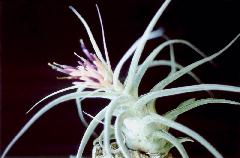
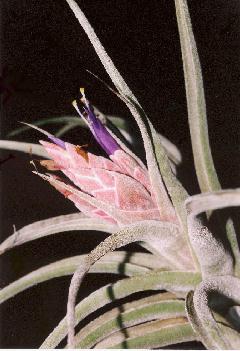
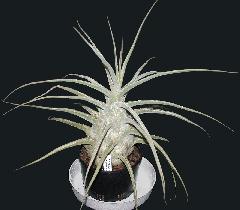
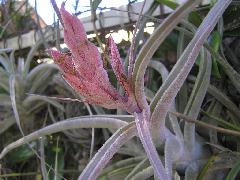
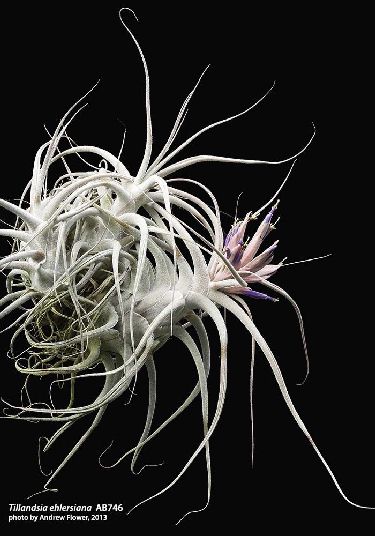
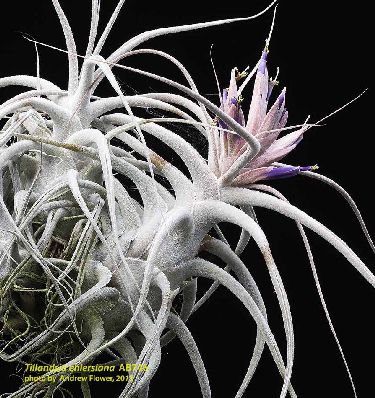
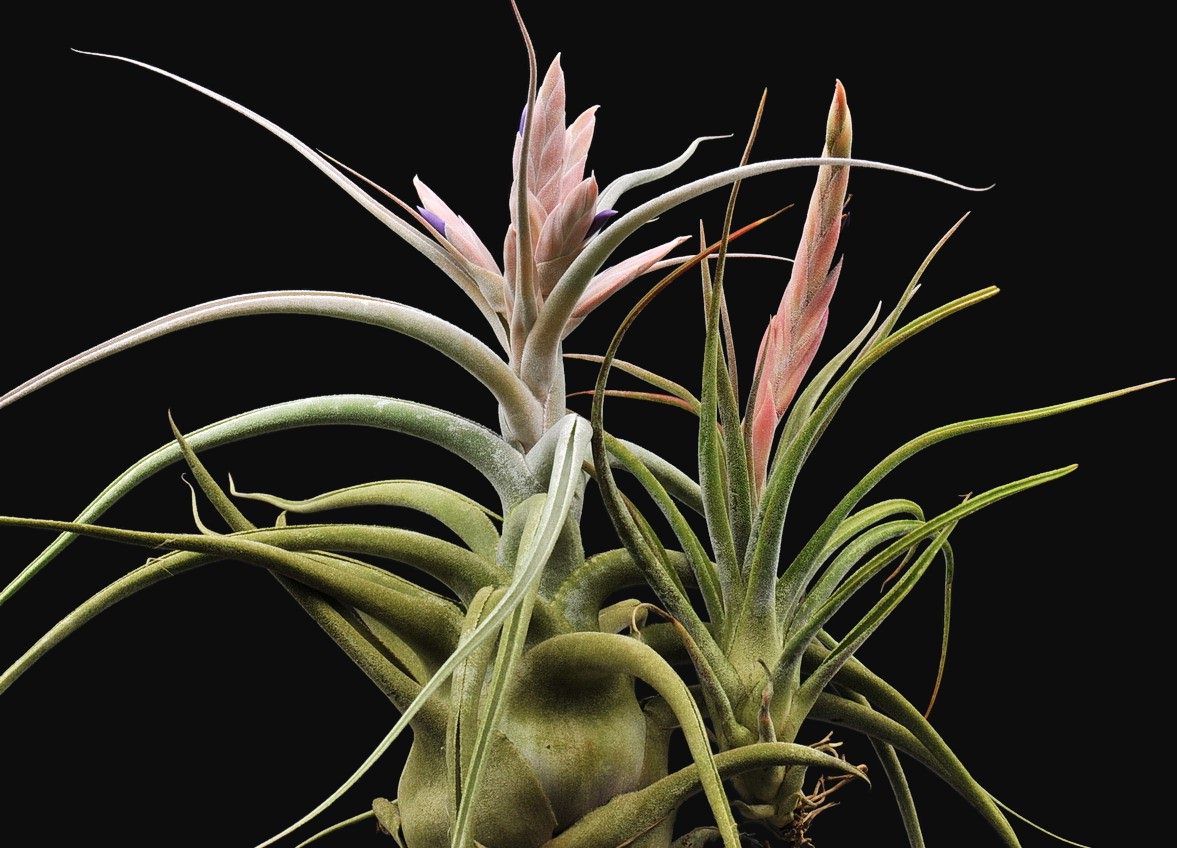
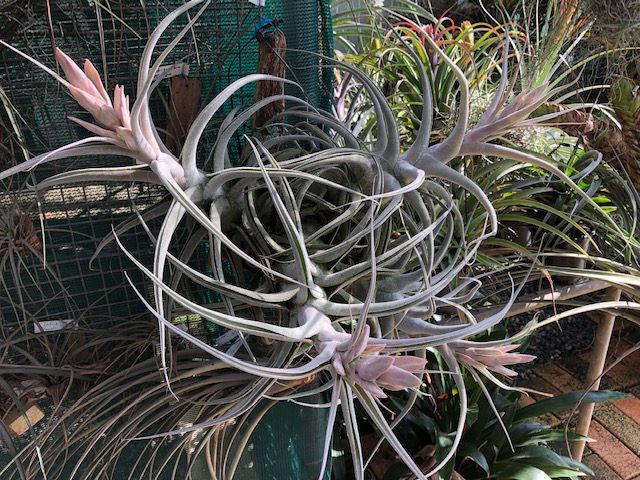
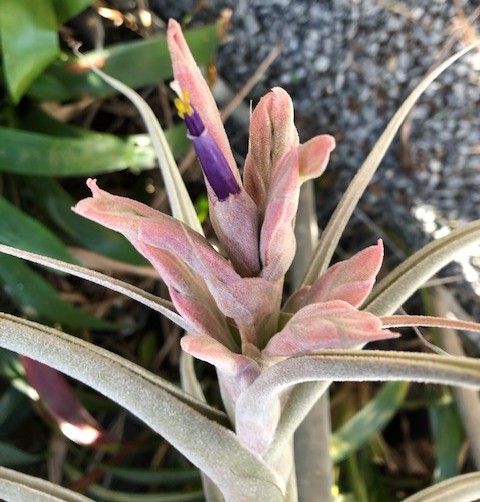
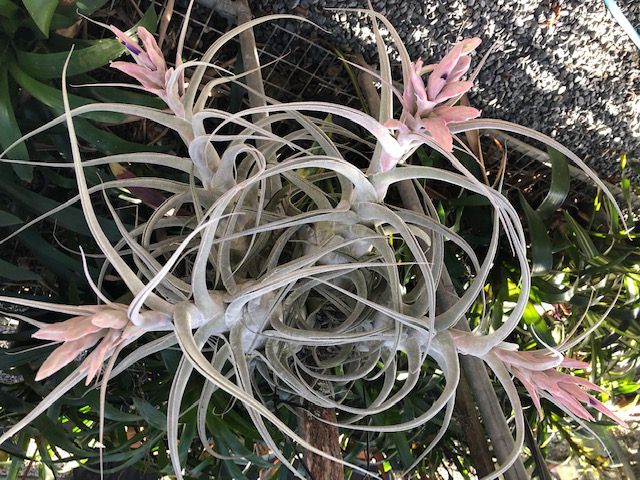
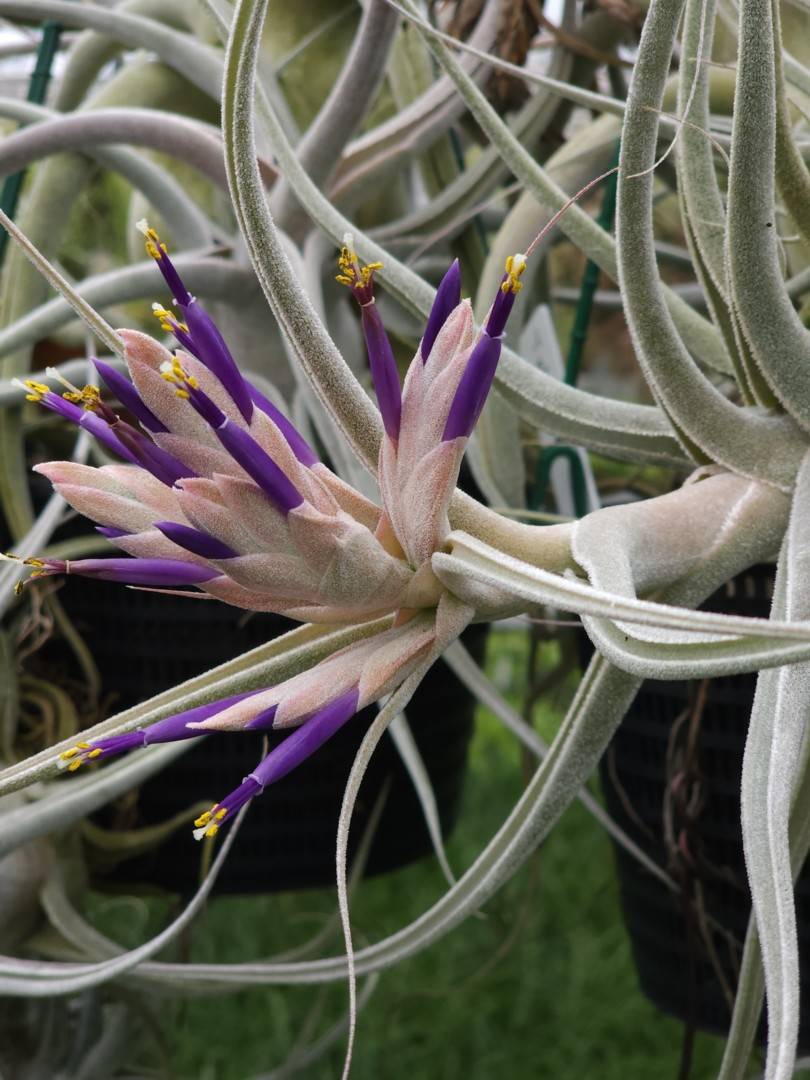
Planta acaulis surculis numerosis, itaque greges densos formans, florens usque ad 20 cm alta. Folia numerosa inflorescentiam superantia. Vaginae late rotundae usque ad 6 (-7) cm latae, 7 cm longae, distinctissime a lamina limitatae, valde inflatae, omnino pseudobulbum cavum usque ad 8 cm latum, 10 cm longum formantia, supra laete alutaceae, subtus canovirides, utrimque dense appresso-albo-lepidotae. Lepides centro viridi-brunneo in parte superiore margine vaginae alato-elongatae. Lamina anguste triangulata supra vaginam usque ad 2.5 cm lata, longe attenuata, valde involuto-subulata, margines in triente basali fistulosa recurvata, interdum paulum torquata, utrimque dense appresso-argenteolepidota; lepides marginum laminae alato-elongatae. Inflorescentia parum e rosula eminens, dense bipinnata; scapus brevis, in rosula occultus, usque ad 7 cm longus, 1 cm diamentiens, viridis appresso-lepidotus; bracteae scapi paucae (ad 3 cm), foliaceae foliis superioribus rosulae similes; inflorescentia oblongoovoidea, usque ad 6 cm longa, 2 cm diamentientia, bipinnata spicis lateralibus plus minusve 4 erectis; bracteae primariae erectae, basales vagina late ovali ad 2 cm longa, 1 cm lata et lamina longa filiformi inflorescentiam longe superanti; bracteae primariae tantum breviter acuminatae spicis breviores; omnes bracteae primariae ut folia dense appresso-argenteo-lepidotae; axis inflorescentiae 7 mm diametiens angulato-applanatus lepidotus; spicae erectae axi appositae, pedicello 5 cm diamentienti applanato lepidoto; usque ad 3 cm longae, 1.8 cm latae, adaxialiter applanatae, abaxialiter convexae, 2-vel 3-florae, flores superiores marcescentes, rhachis angulato-applanatus; bracteae florales dense imbricatae, distincte carinatae, membranaceae, laeves, oblongae acuminatae, 23-25 mm longae, 10 mm latae, subtus dense albo-lepidotae, supra disperse minuto-brunneolepidotae, sepala longe superantes, pallide rufescentes; flores sessiles usque ad 3 cm longi; sepala viresceti-rufescentia, posteriora distincte carinata usque ad basim libera, elongata, acuminata usque ad 13 mm longa, 6 mm lata membranacea, laeves dispersissime lepidota; petala linearia erecta usque ad 3.3 cm longa tubum angustum in dimidio superiore album, in dimidio inferiore violaceum formantia; stamina filamentaque longe exserta, a stylo albo 1 cm superata.
Habitat et distributio: Mexico meridionalis (Chiapas), prope Ocozocouautla abundans ad parietes rupium arduos.
Coll. Renate et Klaus EHLERS, 1.8.1983
Nr. coll.: EHLERS 83/404 (= B.G.H. 58349); Holotypus (in spiritu) in herb. inst. bot. system. univ. heidelbergensi (HEID).
Plant stemless, growing in clumps, flowering up to 20 cm high.
Leaves numerous, exceeding the inflorescence;
Sheaths broad-rounded, 6-7 cm wide and up to 7 cm long, conspicuous, strongly inflated and forming a hollow, up to 8 cm wide and up to 10 cm long pseudobulb, adaxial light leather brown, abaxial graygreen, densely white lepidote on both sides;
Blades narrow-triangular to linear, above the sheath up to 2.5 cm wide, strongly-involute-subulate, the margins forming at the base a nearly closed channel; the upper part of the blades recurved, on both sides densely white lepidote; the trichomes of the margins of the blades strongly asymmetric.
Scape very short, hidden in the rosette, up to 7 cm long, 1 cm thick, round, adpressed lepidote;
scape bracts few (ca. 3), foliate, similar to the upper rosette leaves.
Inflorescence ovoid, bipinnate, much shorter than the rosette leaves, up to 6 cm long, 2 cm thick with ca. 4 erect spikes;
Primary bracts erect; the basal ones with a broad-ovate, 2 cm long and 1 cm wide sheath and a long filiform blade, exceeding the inflorescence; the upper ones only acute, shorter than the spikes; all primary bracts densely silvergray lepidote;
Inflorescence-axis erect, 7 cm long and flattened; spikes erect, short (5 mm), stipitated, up to 3 cm long, 1,8 cm wide, complanate; adaxial somewhat convex, with 2-3 flowers;
Floral bracts imbricate, carinate, membranaceous, even, acute, 23-25 mm brownish-red, much longer than the sepals;
Flowers subsessile, up to 3 cm long;
Sepals greenish-red, the posterior ones sharply carinate, free, oblong, acute, ca.13 cm long, 6 mm wide, membranaceous, even, very laxly lepidote;
Petals linear, erect, up to 3.3 cm long, the upper half blue-violet, white at the base;
Stamens and anthers exserted, shorter than the long, white style;
Capsule unknown.
Type: Renate and Klaus Ehlers 83/404 (= B.G.H. 58 349), 1.7.83. Holotype (in alcohol) in the Herbarium of the Institute of Systematic Botany of the University of Heidelberg (HElD). Currently known from the type-locality only.
Distribution: Southern Mexico, Prov. Chiapas, near Ocozocoautla, 700 m, on steep granitic rocks, in a deciduous forest.
Tillandsia ehlersiana, dedicated to its discoverers Renate and Klaus Ehlers of Stuttgart-Haihingen, West Germany, is a very attractive plant, remarkable for its dense, white silver-gray cloth of trichomes, its channeled and strongly recurved leaves, and ovoid inflorescences. The plant is currently known only from the type-locality. Unlike most of the tillandsias with a pseudobulbous rosette base, which grow epiphytically on trees, this plant grows in masses on steep, granitic rock walls. The closest related species to T. ehlersiana is T. seleriana Mez, which also grows in Chiapas, mostly at altitudes between 2700 and 3100 metres on pine and oak trees.
It differs from T. ehlersiana in the following characteristics:
a. Plant living in a loose symbiosis with ants; mostly bigger than T. ehlersiana.
b. Trichome-cloth not so dense that the plants look greenish, never silvergray.
c. Leaf blades mostly erect and often secund, rarely curved back.
d. Scape evident above the pseudobulb.
e. Inflorescence digitate to subpinnate, not ovoid; spikes mostly spreading and not adpressed to the inflorescence axis.
f. Floral bracts inconspicuous (not sharp), carinate.
g. Posterior sepals 6 mm high, connate (not free).
Tillandsia ehlersiana By Pamela Koide
This is a species that we discovered in the early 1980's in southern Mexican state of Chiapas. In all my years of collecting this was one of the most intriguing discoveries I made. The population of T. ehlersiana was growing abundantly on rock cliffs. Just 30 feet directly in front of the rock cliff were oak trees which were loaded with T. caput-medusae, T.seleriana, T.streptophylla and T. brachycaulos. The trees were also covered with ants. The interesting thing about the population of T. ehlersiana is that it was a hybrid swarm. (A hybrid swarm is a population of plants that appear to be natural hybrids. They are in transition to becoming a species.)
I have discovered many natural hybrids in Mexico. The majority of these are found with just a few plants or a very small population. The T. ehlersiana population had three distinct forms. The typical T. ehlersiana, a form that appears to be a natural hybrid of T. ehlersiana and T. streptophylla, and one that is a natural hybrid of T. ehlersiana and T. seleriana.
The true test for a species is that it can reproduce from seed. We have been growing T. ehlersiana from seed for more than 15 years now, and the seedlings turn out true to T. ehlersiana. I do believe that T. ehlersiana was a natural hybrid, and that it has established as a true species. In all the years that I collected and explored, I believe that with this discovery I was witnessing true evolution of a new species.
This same species was discovered 3 years later by Renate Ehlers and was described by Prof. Werner Rauh as T. ehlersiana.
I have a few photos of T. ehlersiana and T. ehlersiana x T. streptophylla on my site at www.birdrocktropicals.com. Go to the Tillandsia pages, and check under E and also the Tillandsia hybrids.
This article originally appeared in correspondence from the Brom-L discussion group.